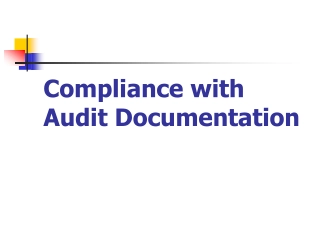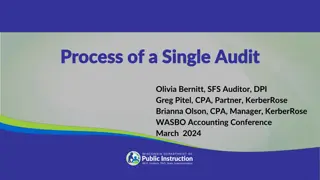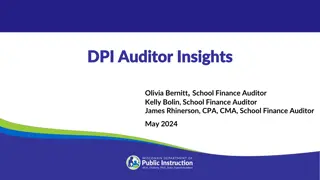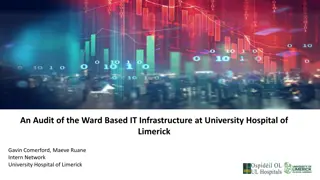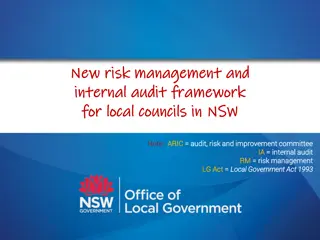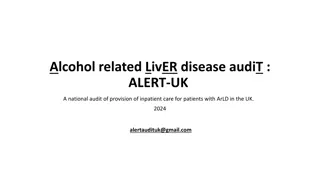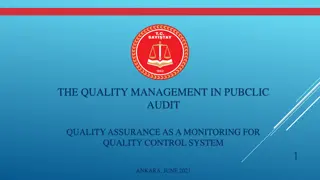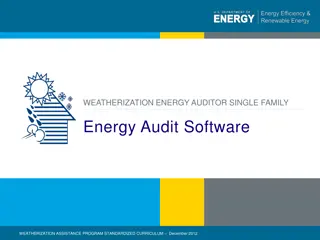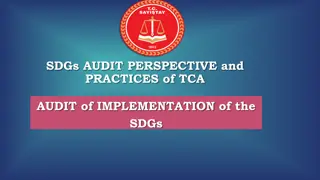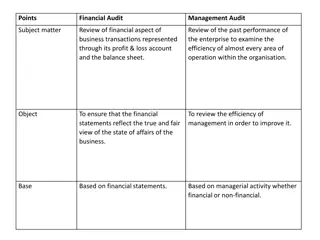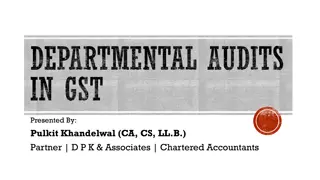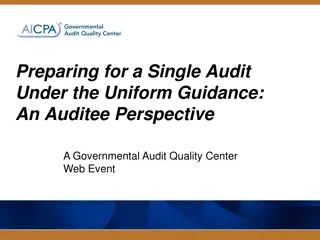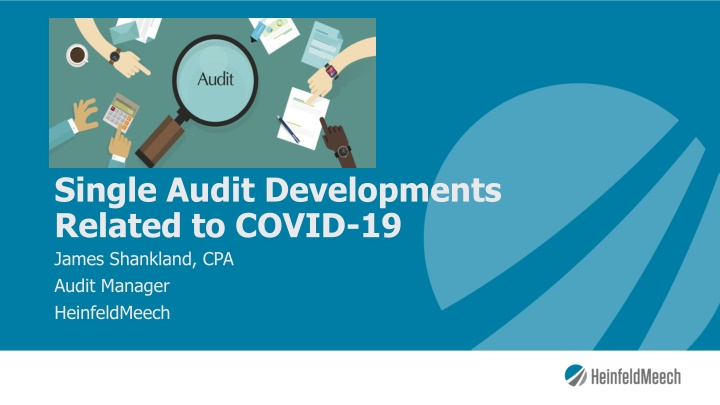
Key Developments in Single Audit Procedures Related to COVID-19
Stay informed about the latest updates in single audit procedures concerning COVID-19, including the Compliance Supplement Addendum, implications of delays, implications on audit submissions, and details on CARES Act funding and programs. Ensure compliance with the new guidelines and mitigate risks effectively.
Download Presentation

Please find below an Image/Link to download the presentation.
The content on the website is provided AS IS for your information and personal use only. It may not be sold, licensed, or shared on other websites without obtaining consent from the author. If you encounter any issues during the download, it is possible that the publisher has removed the file from their server.
You are allowed to download the files provided on this website for personal or commercial use, subject to the condition that they are used lawfully. All files are the property of their respective owners.
The content on the website is provided AS IS for your information and personal use only. It may not be sold, licensed, or shared on other websites without obtaining consent from the author.
E N D
Presentation Transcript
Single Audit Developments Related to COVID-19 James Shankland, CPA Audit Manager HeinfeldMeech
What we will cover today Compliance Supplement Delays and Addendum Addendum released! CARES Act funding Big Items in the Addendum SEFA Reporting & Common Issues Resources 2
Compliance Supplement Addendum Drives audit procedures related to the federal grants Publicly available resource Typically released in June for preliminary fieldwork Released on 12/22/20 Addendum Provides guidance for the testing of CARES Act Funding Coronavirus Relief Funds Provider Relief Funds Education Stabilization Funds Other HUD grants/existing funding guidance
Compliance Supplement Addendum https://www.whitehouse.gov/wp- content/uploads/2020/12/2020-Compliance- Supplement-Addendum_Final.pdf
Compliance Supplement Implications of the Late Release Audit work that was previously done as summer work has been pushed to the fall/winter. March 31 filings could be delayed due to backlog of work 3-month audit submission extension provided by OMB for audits of entities receiving COVID-19 funding Increased risk of non-compliance findings Increased risk of internal control findings 5
COVID-19 funding new and existing programs Largest New Programs Paycheck Protection Program ($>600B) 59.073 NOT subject to Single Audit Provider Relief Fund ($175B) 93.498 Subject to Single Audit, HHS Coronavirus Relief Fund ($150B) 21.019 Subject to Single Audit, Treasury Ed Stabilization Funds ($30.75B) 84.425 Subject to Single Audit, Education Federal FAQ includes a comprehensive listing of existing federal programs that were funded through the CARES Act and other supplemental appropriations to support response to the COVID-19 crisis. Listing can be found in Appendix A to the FAQ https://www.cfo.gov/wp- content/uploads/2020/06/M- 20-21_FAQ_06232020.pdf 7
Audit Extensions Appendix VII of the Addendum to allow recipients/subrecipients that received COVID-19 funding, to have a 3-month extension. Still can be considered low-risk auditee No further action by awarding agencies is required to enact this extension Doesn t require approval Recipients/subrecipients should maintain documentation of the reason for the delayed filing. No receipt of COVID-19 funding ?? NO EXTENSION!
New Reporting Requirement FY 20 a new reporting requirement is being added that will need to be tested for all COVID-19 programs in the addendum. This will be extended to ALL programs for audits of fiscal years ending after 9/30/20, regardless of COVID monies. All Direct recipients who make first-tier subawards of $25,000 or more are to report the subaward data through the FFATA Subaward Reporting Systems (also referred to as FSRS) available at USASpending.gov as the publicly available Web site for viewing this information (https://www.usaspending.gov/search) 10
New Reporting Requirement The auditor MUST test FFATA reporting for all of the COVID- 19 programs included in the Addendum (except for CRF): As long as the reporting type of compliance requirement is marked Y in Part 2 Matrix and auditor determines to be direct and material. The recipient makes the first-tier subawards/subcontracts of $25K CRF is not subject to FFATA reporting based on Treasury OIG Reporting guidance (FAQ 31). This requirement will be extended to all Major Programs regardless of COVID-19 funding being in FY 21. 12
How Will Auditors Test This? Select a sample of subawards and determine if subject to FFATA reporting Find the awards in FSRS Only accessible by the recipient, but can be done remotely using technology Compare the award information Report any instances of noncompliance 13
PPE Donations The Notes to the SEFA need to include a footnote with the amount of donated PPE (from federal assistance) but it can be marked as unaudited . 14
Office of Management and Budget (OMB) FAQ Released late November 2020 Effective on all expenditures charged to Federal awards as of August 13, 2020 Prohibition on Covered Telecommunication and Video Surveillance Service or Equipment Any Covered Equipment or Services produced by Huawei Technologies Co, ZTE Corporation, Hytera Communications Corporation, Hangzhou Hikvision Digital Technology Co, or Dahua Technology Co. (or any subsidiary or affiliate of such entities) Check www.sam.gov to see if the entity is in the excluded parties list 15
Part 2 Matrix Section Matrix provided for all new programs (noted with new after the title and bolded) and existing programs included A new non-COVID-19 program was added 20.218 17
New Programs in the Addendum New COVID-19 Programs 16.034 Coronavirus Emergency Supplemental ($850 M) 21.019 Coronavirus Relief Fund ($150 B) 32.006 Telehealth Program ($200 M) 84.425 Education Stabilization Fund ($30 B) 93.461 Uninsured Testing Portal ($2 B) 93.498 Provider Relief Fund ($175 B) Non-COVID-19 Additions 20.218/20.237 Federal Motor Carrier Safety Assistance (FMCSA) Cluster 18
Coronavirus Relief Funds (CRF) Purpose: to provide direct payments to state, territorial, tribal and other local governments to cover: 1. Necessary expenditures incurred due to the public health emergency with respect to COVID-19 2. Costs that were not accounted for in the governments most recently approved budget as of March 27, 2020 3. Costs that were incurred during the period that begins on March 1, 2020 and ends on December 30, 2020 Also known as ESG Funds to AZ School Districts (Fund 328) 19
Activities Allowed/Allowable Costs Activities Allowed or Unallowed refers auditors to the following documents: Treasury CRF Guidance Document (https://home.treasury.gov/system/files/136/Coronavirus-Relief- Fund-guidance -for-State-Territorial-Local-and-Tribal- Governments.pdf) Treasury CRF FAQ document (https://home.treasury.gov/system/files/136/Coronavirus-Relief-Fund- Frequently-Asked-Questions.pdf) Uniform Guidance cost principles, don t apply- rather refer to Treasury guidance and FAQS when testing the allowability of costs. 20
Activities Allowed/Allowable Costs Nonexclusive examples of eligible expenditures: Expenses for communication and enforcement by State, territorial, local, and Tribal governments of public health orders related to COVID-19 Expenses for disinfection of public areas and other facilities Expenses for public safety measures taken in response to COVID-19 Expenses to improve telework capabilities for public employees Increased workers compensation cost due to the public health emergency Expenses associated with contract tracing Payroll expenses for public safety, public health, human services, and similar employees whose services are substantially dedicated to mitigating or responding to the COVID-19 public health emergency 21
Activities Allowed/Allowable Costs Nonexclusive examples of ineligible expenditures: Expenses for the State share of Medicaid Damages covered by insurance Capital improvement projects that broadly provide potential economic development Payroll or benefits expenses for employees whose work duties are not substantially dedicated to mitigating or responding to the public health emergency* *Administrative accommodation (covered on next slide) 22
Activities Allowed/Allowable Costs Administrative Accommodation Treasury has provided, as an administrative accommodation, that a state, local, or tribal government may presume that public health and public safety employees meet the substantially dedicated test, and that work performed by such employees is considered to be a substantially different use than accounted for in the most recently approved budget as of March 27, 2020. All costs of such employees may be covered using payments from the Fund for services provided during the period that begins on March 1, 2020, and ends on December 30, 2020. 23
Activities Allowed/Allowable Costs Administrative Accommodation Treasury has supplemented this guidance to clarify that public safety employees would include: Police officers Sheriffs and deputy sheriffs Firefighters Emergency medical responders Correctional and detention officers Those who directly support such employees Such as dispatchers and supervisory personnel 24
Period of Performance and Reporting Auditor s will focus on the requirement that governments must use the payments for necessary expenditures incurred between March 1, 2020 and December 30, 2020 Passage of coronavirus relief package in December 2020 extended this to 12/31/21 Unspent funds shall be returned to the Treasury FFATA N/A for CRF however: Reporting section will have the auditor focus on required quarterly reporting by prime recipients in the Treasury GrantSolutions portal Refer to the Treasury OIG FAQ that discusses prime recipients and reporting. https://www.treasury.gov/about/organizational- structure/ig/Audit%20Reports%20and%20Testimonies/OIG-CA-20-028.pdf 25
Education Stabilization Funds (ESF) Funding provided to prevent, prepare for, and respond to coronavirus, domestically or internationally Program divided into grant types or subprograms in the Compliance Supplement designated by the letters The subprograms are further grouped into 2 separate sections in the Addendum Section 1 is comprised of those governed by the Education Stabilization Fund (84.425 A, C, D, H) Section 2 is comprised of those governed by the HEERF (84.425 E, F, J, K, L, M, N) 84.425 B, G (not subject to audit in FY 20) 84.425 P Use Part 7 to audit 26
Education Stabilization Fund Sections Education Stabilization Fund Discretionary Grants 84.425B, 84.425G (not subject to audit in FY 20) Governor s Emergency Education Relief Fund 84.425C (FY 21) Fund 327 for AZ School Districts Elementary and Secondary School Emergency Relief Fund 84.425D Fund 326 Formula Grants to the Outlying Areas 84.425A, 84.425H 84.425 is considered one program for major program determination purposes 27
Elementary and Secondary School Emergency Relief Fund (ESSER) 84.425D Application period was over the summer 2020 Through ADE GME operates on a reimbursement basis similar to other grants Begin drawing funds as soon as they are expended and requested Available for obligation anytime on or after 3/13/20 through 9/30/22 State can t restrict or limit the LEA use of ESSER formula funds- broad permissive list of allowable LEA activities in Section 18003d. Doesn t contain a Maintenance of Effort (MOE) requirement 28
Governors Emergency Education Relief Fund (GEER) 84.425C On 11/10/20 the Governor s Office and ADE announced $19 million to help AZ students most impacted by COVID-19. Called the Acceleration Academies Eligibility based on Free and Reduced Lunch applications Not Proficient AZMerit ELA and Math scores Unemployment claims in zip codes COVID cases in zip codes No access to computer/internet in zip codes May use for any allowable expenditure incurred on or after March 13, 2020 29
Governors Emergency Education Relief Fund (GEER) 84.425C Base Funding- award of $75K to 183 qualifying Districts Impact Funding- 37 highest need Districts received additional $100K Enrollment Funding - 10 largest of these received an additional $157,500 Funding will be through ADE GME and operate similar to other reimbursement grants 30
ESF guidance for the SEFA Maintain records of the which alpha suffix belongs to expenditure line items. Recipients should identify individual programs the funds were expended under, including each separate Assistance Listing with the applicable alpha character A total for the ESF in its entirety should also be provided 31
Links for Relevant Guidance on ESF Frequently Asked Questions about the Governor s Emergency Education Relief Fund (GEER Fund) (https://oese.ed.gov/files/2020/05/FAQs-GEER-Fund.pdf) FAQs about the Elementary and Secondary School Emergency Relief Fund (ESSER) (https://oese.ed.gov/files/2020/05/ESSER-Fund-Frequently-Asked- Questions.pdf) FAQs- ESF State Educational Agency (https://oese.ed.gov/files/2020/09/ESF-SEA-Final-FAQs.pdf FAQs- ESF Governors (ESF-Governor) (https://oese.ed.gov/files/2020/09/ESF-Governor-Final-FAQs.pdf) 32
Existing Food and Nutrition Service Program -10.001 This section includes reminders about waivers provided due to COVID-19 on the following programs: 10.551 - Supplemental Nutrition Assistance Program 10.553 - School Breakfast Program 10.555 National School Lunch Program 10.557 Special Supplemental Nutrition Program for Women, Infants, and Children 10.558 - Child and Adult Care Food Program 10.559 - Summer Food Service Program 10.572 - Farmer s Market Nutrition Program (was not included in August release) 33
Existing Food and Nutrition Service Program -10.001 USDA states in this section that it expects instances when it is not possible to perform certain audit steps as written in the August 2020 Supplement due to COVID-19 and the subsequent closures, as in the case of the public schools. Instructs that such instances should be documented by the auditors however they haven t indicated how yet. 34
Appendix VII There are links to agency websites and guidance documents in the Addendum to communicate an agency s understanding of how relevant statutes, terms and conditions, etc. apply to particular circumstances However they don t create new compliance requirements Auditors use these documents during the period to understand the program requirements There is changing guidance being created over time and often after the audit is complete. OMB has indicated to look at the guidance that exists at the time. 35
Single Audit Reporting Package Instructions for how recipients should separately identify COVID-19 related awards on the SEFA and the DCF i.e. 93.558 Temporary Assistance for Needy Families 93.558 COVID-19-Temporary Assistance for Needy Families 84.425A COVID-19 Education Stabilization Fund- State Education Agency (Outlying Areas) (ESF-SEA) Use the OMB Compliance Supplement or beta.sam.gov for proper Grant Names 37
Notes to the SEFA DONATED PPE Per OMB Memo M-20-20 Federal agencies and recipients could donate PPE purchased with federal assistance funds to various entities for the COVID-19 response Mostly provided with no compliance or reporting requirements Nonfederal entities that received such donated PPE should include the FMV of the PPE at time of receipts in a stand-alone footnote to the SEFA that can be marked unaudited The donated PPE should NOT be counted for purposes of determining the threshold for a single audit or the type A/B program threshold for major programs. Not required to be audited as a major program 38
Single Audit Reporting Package Identification of COVID-19 related awards is necessary in the audit findings as well. Finding Number: 2020-001 Repeat Finding: No Program Name/CFDA Title: COVID-19 Temporary Assistance for Needy Families CFDA Number: 93.558 Federal Agency: U.S. Department of Health and Human Services Federal Award Number: Pass-Through Agency: Questioned Costs: $____________ Type of Finding: Noncompliance, Significant Deficiency, Material Weakness select as appropriate Compliance Requirement: 39
Risk Evaluation Process Determining major programs for Single Audit Testwork Risk Assessment process hasn t changed Likely that many new/different grants will be tested Type A Programs previously considered low-risk may change to high-risk based on factors such as change in personnel or systems due to COVID-19 which could increase program risk. Type B Programs could have additional funds added to existing programs that trigger new risk factors 40
Audit Findings Been an increasing area of focus by Federal Agencies, even prior to COVID-19 pandemic. Requests for more detail and proper reference to criteria Expected to be increased scrutiny and follow up by Federal agencies over the COVID funding Ensure findings are very detailed Expectation of increased internal control findings due to shutdowns and reprioritizing Grants worked differently this year- money first, guidance for testing and requirements for allowability second 41
Subrecipient Monitoring Entity may not have been a Pass-Through Entity in the past, but may be in that position now with CARES funding. http://www.heinfeldmeech.com/subrecipient-monitoring-ug/ From an audit perspective: Subrecipient monitoring may be direct and material for the first time for a grant Higher risk area CAUTION: If you are passing funds through to other entities- be sure you are familiar with the requirements for subrecipient monitoring http://www.heinfeldmeech.com/subrecipient-monitoring-ug/ http://www.heinfeldmeech.com/subrecipient-monitoring-ug/ 42
Performing the Single Audit Testing SEFA accuracy and completeness Programs and amounts may be harder to identify Keep close track of all federal funds that are received by entity Separate account codes Keep Grant agreement documentations Internal Control testing Need for more testing due to changes in controls Potential for increased sample sizes if the controls can t be relied upon Federal agencies are focusing on findings Potential for increased number of findings and Federal agency follow-up 43
Audit Timing Some entities may be issuing Financial Statements separately from the Single Audit Dual dated reports If there is delayed filing of a Single Audit with FAC, the reporting package will need to indicate the reason for the delay There may be delays this year! 44
How To Prevent Errors Make sure to double-check grant names at beta.sam.gov Tracking grants by separate project/account codes or in entirely separate fund Centralization of grant tracking process 45
Questions James Shankland, CPA James.Shankland@heinfeldmeech.com 46

